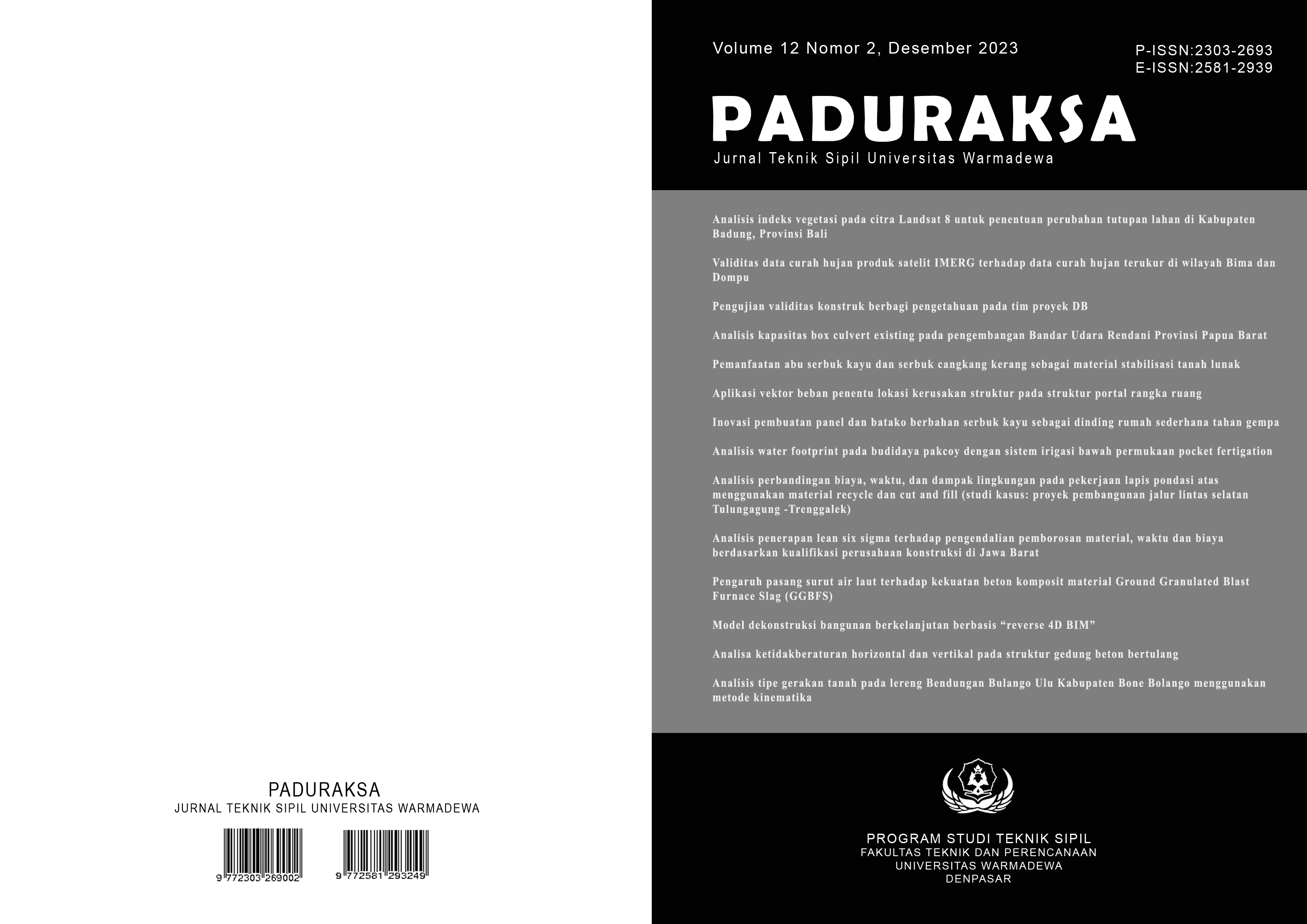Aplikasi vektor beban penentu lokasi kerusakan struktur pada struktur portal rangka ruang
Abstract
Structural health monitoring system is one of the most interesting and important topics in civil engineering. This is because a good structural health monitoring system will increase the reliability of the structure. There are 4 (four) levels in the structural health monitoring system, one of which is damage localization. Damage localization requires an approach or method that can accurately predict the damaged member. One of the methods that is widely applied and proven to give good results for predicting damaged members called damage locating vector (DLV). The DLV method has been applied to several structures, such as plane truss structures, space truss structures, plane frame structures, shear buildings, plane stress elements, thick plate elements and several types of structures. The purpose of this research is to apply DLV method to space frame structures to find out the effectiveness of this method in damage detection. There are three damage scenarios used, two single damage scenarios and one multiple damage scenario. Based on the results obtained, the DLV method can accurately determine the damaged member in the space frame structure for single damage scenarios but in case of multiple damage scenarios, the DLV cannot predict the damaged member due to the values ​​of the end forces and moments of the damaged members are similar to one another.
References
Aguilar, R., Zonno, G., Lozano, G., Boroschek, R., & Lourenco, P. B. (2019). Vibration-based damage detection in historical adobe structures: laboratory and field applications. International Journal of Architectural Heritage, 13(7), 1005-1028. https://doi.org/10.1080/15583058.2019.1632974
Arfiadi, Y. (2011). Analisis Struktur dengan Metode Matriks Kekakuan. Cahaya Atma Pustaka.
Avci, O., Abdeljaber, O., Kiranyaz, S., Hussein, M., Gabbouj, M. & Inman, D. J. (2020). A review of vibration-based damage detection in civil structures: from traditional methods to machine learning and deep learning applications. Mechanical Systems and Signal Processing, 147, 107077, https://doi.org/10.1016/j.ymssp.2020.107077
Bernal, D. (2000). Extracting Flexibility Matrices from State-Space Realizations.
Bernal, D. (2002). Load Vector for Damage Localization. Journal of Engineering Mechanics, 128(1), 7-14. https://doi.org/10.1061/(ASCE)0733-9399(2002)128:1(7)
Computer & Structures, Inc. (2016). CSI Analysis Reference Manual for SAP2000, ETABS, SAFE and CSiBridge, Computer & Structures, Inc,
Frans, R., Arfiadi, Y., & Parung, H. (2017). Comparative study of mode shape curvature and damage locating vector methods for damage detection of structures. Procedia Engineering, 171, 1263-1271. https://doi.org/10.1016/j.proeng.2017.01.420
Frans, R. & Arfiadi, Y. (2017). Structural damage detection using MAC-Fast Multi Swarm Optimization technique (MAC-FMSO). Matec Web of Conferences. 138, 02020. https://doi.org/10.1051/matecconf/201713802020
Frans, R. & Arfiadi, Y. (2018). Aplikasi vektor beban penentu lokasi kerusakan pada struktur plane stress. Seminar Nasional Riset dan Teknologi Terapan 8 (RITEKTRA 8), Universitas Atma Jaya Makasar.
Frans, R. & Arfiadi, Y. (2020). Aplikasi metode vektor beban penentu lokasi kerusakan pada struktur thick plate. Jurnal Teknik Sipil, 15(4), 209-217. https://doi.org/10.24002/jts.v15i4.3792
Kattan, P. I. (2008). MATLAB guide to finite elements an interactive approach. Springer.
MathWorks. (2015). MATLAB: Primer, Version 8.6. The Mathworks, Inc.
MathWorks. (2015). MATLAB: Programming Fundamental, Version 8.6. The Mathworks, Inc.
Nguyen, T. T., Tran, V. A., Nguyen, M. N., Vo, D. T., & Ho, H. V. (2018). A combination of damage locating vector method (DLV) and differential evolution algorithm (DE) for structural damage assessment. Frontiers of Structural and Civil Engineering, 12, 92-108. https://doi.org/10.1007/s11709-016-0379-1
Rytter, A. (1993). Vibration based inspection of civil engineering structures [Doctoral dissertation, Aalborg University]. Department of Building Technology and Structural Engineering.
Authors who publish with this journal agree to the following terms:
- Authors retain copyright and grant the journal right of first publication with the work simultaneously licensed under a Creative Commons Attribution License that allows others to share the work with an acknowledgement of the work's authorship and initial publication in this journal.
- Authors are able to enter into separate, additional contractual arrangements for the non-exclusive distribution of the journal's published version of the work (e.g., post it to an institutional repository or publish it in a book), with an acknowledgement of its initial publication in this journal.
- Authors are permitted and encouraged to post their work online (e.g., in institutional repositories or on their website) prior to and during the submission process, as it can lead to productive exchanges, as well as earlier and greater citation of published work (See The Effect of Open Access).
 Abstract viewed = 144 times
Abstract viewed = 144 times
 PDF downloaded = 116 times
PDF downloaded = 116 times










